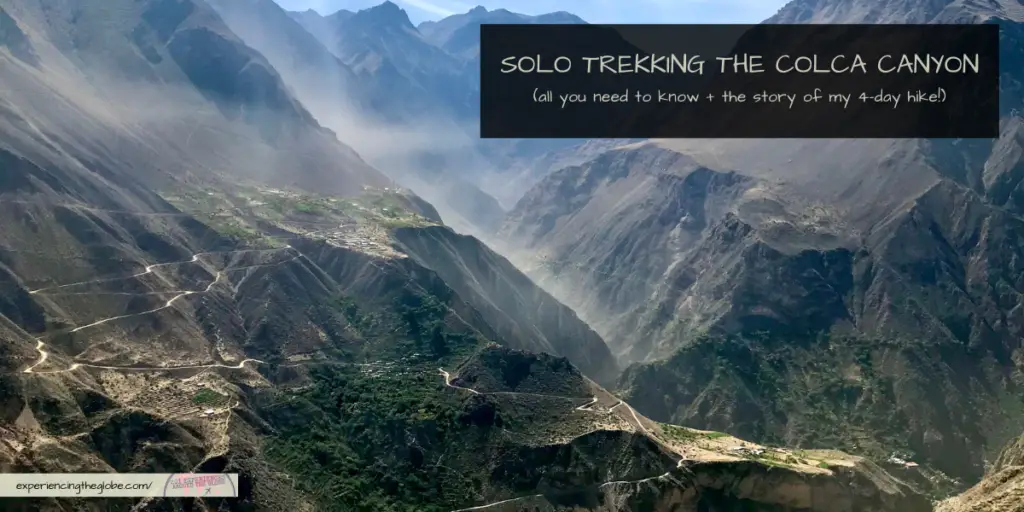
When I heard that the Colca Canyon is one of the deepest and biggest in the world, I knew I had to experience it. And what better way than trekking? The walk is easy, the locals said. The hike is dangerous, Peruvian from other regions said. The trek is rewarding, foreigners that did it said. It sounded like a fun challenge, type II fun, but fun nonetheless. So off I went, to attempt solo trekking the Colca Canyon for 4 days. Here’s an account of how the hike went, how much of a challenge it actually was, and all the questions you might have, answered.
Itinerary overview for solo trekking the Colca Canyon
After asking lots of people and reading the little updated info I found online, I decided to skip the most touristy places, around the town of Chivay, and go deeper into the canyon instead, starting from Cabanaconde.
From there, there are a few established loops, allowing you to stay in the canyon for 2 to 4 days. Even though you only have up to 6 hours of actual trekking a day, all the alternatives’ level of difficulty is deemed as “challenging”.
The consensus was that the nicest seccion was the one that makes the hike the longest. But as there are little villages along the way offering lodging, I didn’t need to carry a tent. My only worry was meals (being a vegan), so most of the weight in my backpack would be food. With only those thoughts in mind I figured I could tackle the 4-day trek.
This is how it goes. On day 1 from Cabanaconde (3287m/10784ft) you go to the ridge, to a viewpoint (Mirador Achachiwa) from where you can grasp for the first time how massive the canyon is. From there you go all the way down to the bottom of the canyon, to the Colca river. You cross it, go alongside it until you reach the Huaruro river, cross it too, and climb up a bit to the village of Llahuar (2020m/6627ft). There are natural hot springs there, providing a great recovery.
The second day is on the other side of the canyon towards Fure, what I was told was the prettiest leg of the hike (with which I completely agree). You go up the valley and walk parallelly to the Huaruro river, until the village of Llatica (2470m/8104ft). Then it’s down the canyon, across the river, following it upstream, and crossing it one more time. Then back up to the village of Fure (2900m/9514ft). From there you can add a 40-minute hike to Huaruro waterfall.
On day 3 you backtrack across the river, but take a higher path following the ups and downs of the ridge towards the village of Belén (2530m/8300ft), then up to Apacheta viewpoint (2700m/8858ft), and then all the way back down the canyon to the oasis (and village) of Sangalle (2100m/6890ft). This is the most visited place on this side of the canyon, so accommodations offer bars and swimming pools. Not really what I would have looked for in a peaceful trek, but it ended up being a nice way to unwind after a long and hard day.
The final day is an endless zigzag back up to Cabanaconde (3287m/10784ft). If you do it in the morning, you can catch a bus back to Arequipa on the same day.
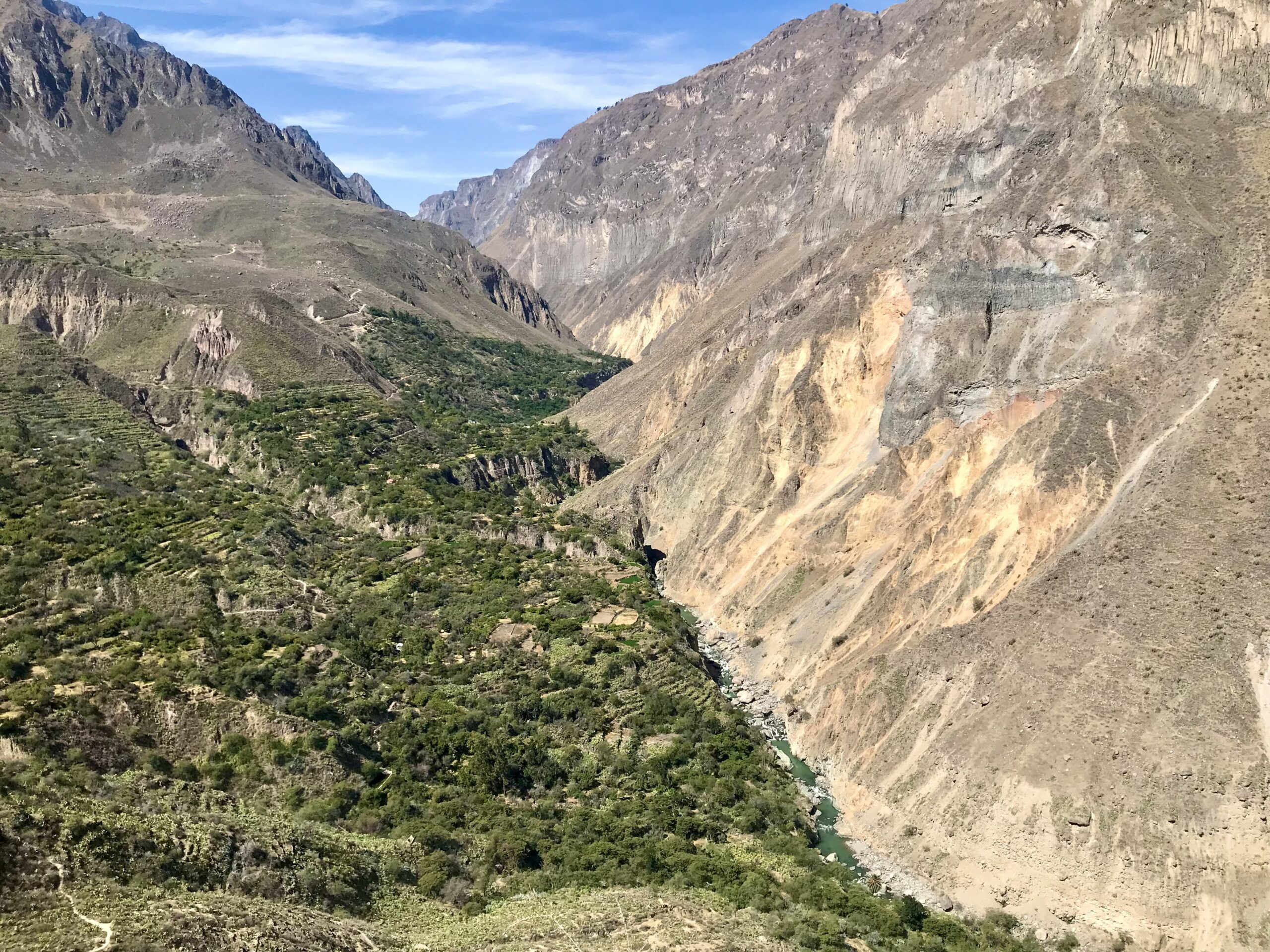
The story of my first solo multi day hike, stop by stop
Day 0: Preparations (or lack of)
I decided to go to Arequipa only to tackle this trek, so I thought a day in town would be enough to get supplies, info on how to get to my starting point, Cabanaconde, and have a quick look around town. Turns out the city is much prettier than I expected, so I spent the day sightseeing, and left the important things for last minute (because adulting is not my strongest suit). In the only store that was still opened I got a few cans of beans, some nuts, and a couple of packs of cookies. And my hostel provided some info on the starting point of the transportation I needed.
I woke up early, found a minivan to the entry point of the canyon, the town of Chivay, and from there another to Cobanaconde. I got accommodation for the night, bought a map of the canyon so I wouldn’t solely rely on my phone, packed for the trek (and put all the rest of my belongings in my daypack, which stayed behind), filled my water bottle, and went to sleep feeling ready for my first solo multi day trek. Oh, sweet summer child!
RELATED POST → Eco-friendly hiking: sustainable tips and packing guide
Accommodation: there are plenty of alternatives in Cabanaconde, but try to book ahead. Homestay Pachamama was recommended to me, but it was fully booked when I reached it. I did go for dinner there and bought their map of the canyon, which is the most up-to-date resource for the hike. I ended up staying in nearby La Posada del Conde. Although the place was a bit dated, everything went smoothly, and I’m very grateful to them for storing my stuff while I went on the trek.
Day 1: f*ck this sh*t (aka finding my mantra)
Cabanaconde to Lllahuar
13k/8mi, 150m/492ft of ascent, 1300m/4265ft of descent, 5:30 hours
We’re mostly water. That little fact that we learn in primary school was re-learnt, in the harshest way.
I’m going into a fairly barren canyon, with nowhere to hide from the sun for kilometers on end. Although is wintertime (beginning of August to be precise), the temperatures in the region are nice and balmy (around 20°C/70°F during the day). But somehow in “all” my preparation I never thought about the amount of water I could need. About a liter would be enough, right? I have a water filter and there’s a river to be crossed, so why put more weight into my backpack, right?
A couple of hours in, with the sun relentlessly shining on my face, I drank my last drop of water. But the thought of the river at the end of the canyon kept me going. I was slowly shutting down, though. So when I reached the river and realized that the bridge was quite high up, and that getting to the riverside would add a good half an hour to my hike, I decided to keep pushing to Llahuar, my destination for the day.
I stopped to rest in the first place I found with some shade, and all I wanted was to go to sleep. My body had never shut down like that. As I forced myself to continue, I realized that I was tired, but what was unbearable was the thirst. At that point I had reached a road that 4WD vehicles (and horses) occasionally use to supply the village, so I thought to just stay there and hope it was restocking day so I could be rescued.
While all I could process were thoughts of giving up, suddenly I remembered fellow traveler Eva zu Beck’s mantra. It just appeared in my mind and flushed my whole being. “This is hard, but I can do hard things”. As I began to nod, my body started to wake up. I was still parched and moving in slow motion, but I was moving. My own newfound mantra suddenly flooded my thoughts. “Keep pushing on, I’m becoming the person I want to be”.
See, I have always wanted to be this badass adventurer chick. Here was the chance to prove myself that I was already a badass adventurer chick. Stand up and finish this, Coni!
A few hundred meters ahead I passed by a little stream of water. I must have drank a few litters, non-stop. And after that Llahuar felt like it was just around the corner.
When I arrived at my home for the night, I crashed in a hammock overlooking the canyon and I drank another liter of water (mixed with a rehydration pack, which I decided to drink every of the following mornings, just in case). When I felt like a human again, I changed into my bathing suit and spent the whole afternoon relaxing in a hot spring, chatting to other trekkers. Thoughts of returning to Cabanaconde the next day kept creeping into my thoughts, but I shoved them away –I wanted to at least try to push forward.
Accommodation: There are only two alternatives. Llaguar Lodge and Casa de Virginia. I chose the latter, because it was the smallest, so I figured it’d be the quietest, and I’m very glad I did. It was humble but very well maintained. It has a hot tub filled from a natural spring, and hammocks around the garden, what else could I need?
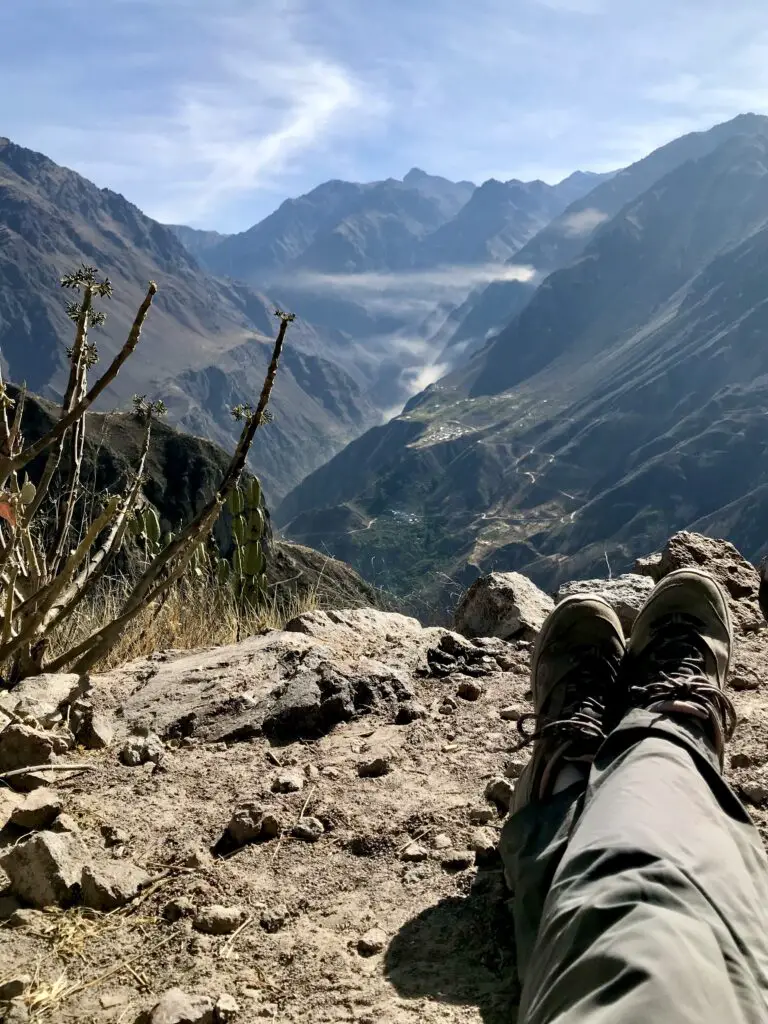
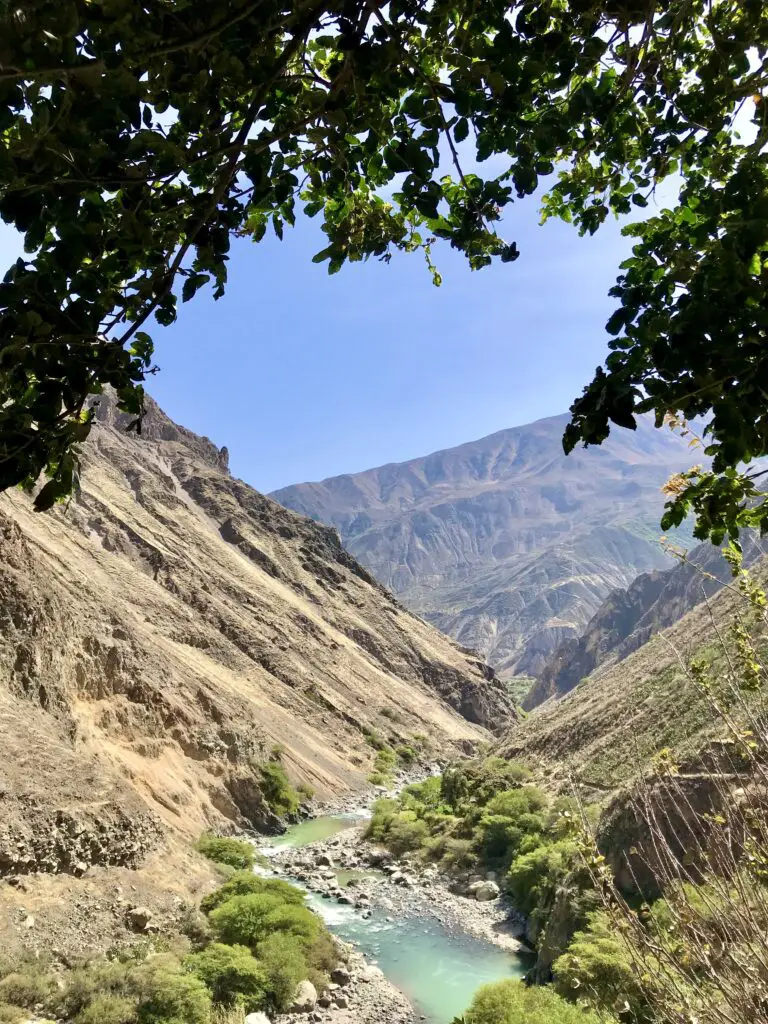
Day 2: I’m invincible
Llahuar to Fure
7k/4.4mi, 900m/2953ft of ascent, 100m/328ft of descent, 5 hours
After a hearty breakfast, a hydration pack, and a 3-liter bottle of water purchased, I started to hike up the other side of the canyon.
The scenery here was very different –more greenery, some streams, no people. Since a 2-day version of the trek that only loops from Cabanaconde to Llahuar and back is very popular, on the first day you run into lots of people on the way. This leg, on the other hand, is not very common, so I spent most of the day without seeing a single soul (I actually only saw locals, not even one more hiker).
I don’t know if it was that I was better prepared, or that my mantra was constantly being played in the back of my mind, or that I felt really badass hiking alone, but the whole day was incredible. A feeling of empowerment filled my soul, I was invincible.
I had so much gratitude for all those people that I met earlier on this trip that encouraged me to do this trek, when I was thinking I wasn’t strong enough.
The day was tiring, but it flew by. I reached Fure with an overjoyed heart, and I spent the afternoon just taking it all in.
There’s an option of going to a waterfall nearby, but I skipped it. I didn’t need anything else.
Extract from my journal
I embark on lots of adventures thinking that I will love having done it. I know that I won’t necessarily love the experience itself, but I will love knowing I did it. This hike is one of those times. I was equally excited and anxious. So much could go wrong. My knee could get more f*cked up. I could easily fall or get lost. What if I just can’t make it? I wanted to wake up 4 days later and look back at the cool experience that was behind me.
But today I felt differently. I enjoyed being here. I had fun negotiating the uphills. I even welcomed the pain in my legs and back, knowing that it meant I’m getting stronger. I was delighted to see birds go around the flowers nearby when I stopped to eat beans straight from a can, with no humans anywhere around. I loved the feeling of accomplishment that surrounded my mind while I spent the afternoon relaxing, listening to the river roar as I read a book. Today I’m simply happy to be here, no matter how the adventure finishes.
Accommodation: Fure is a bit of a ghost town –most people left the village due to its inaccessibility. There’s only one lodging option, Fure Wassi, but it’s not always opened, so make sure you call them first (941898690 or 944676383). You get a small cabin in a stunning setting. Although it was the humblest, it was my favorite place to stay in the canyon.
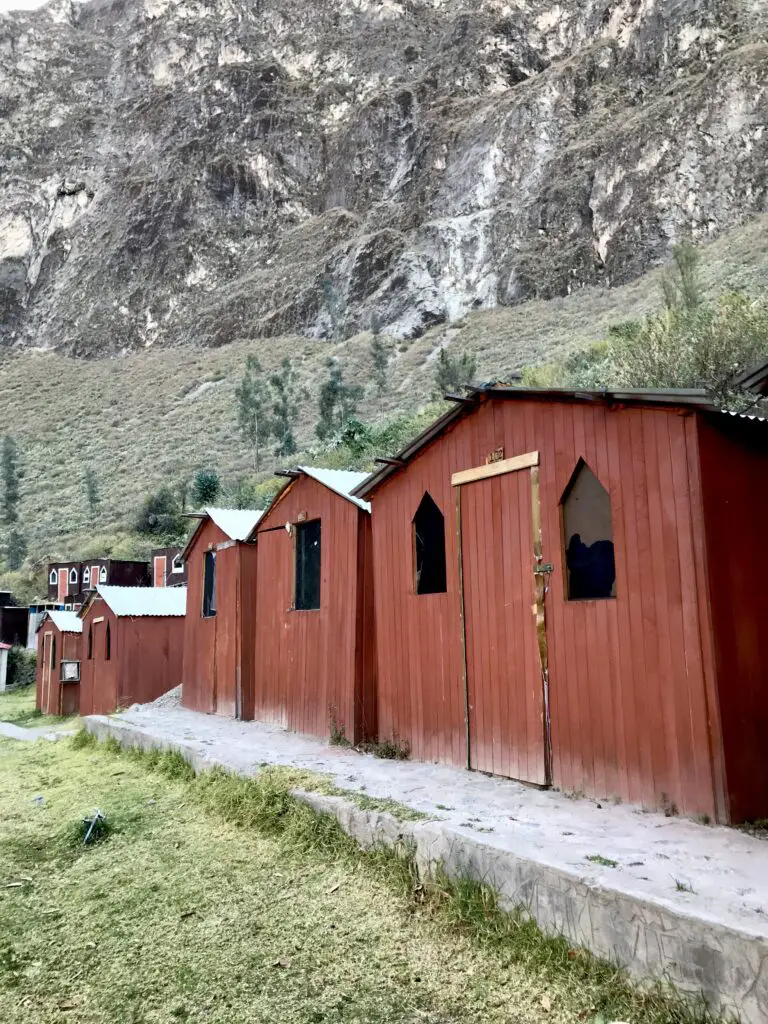
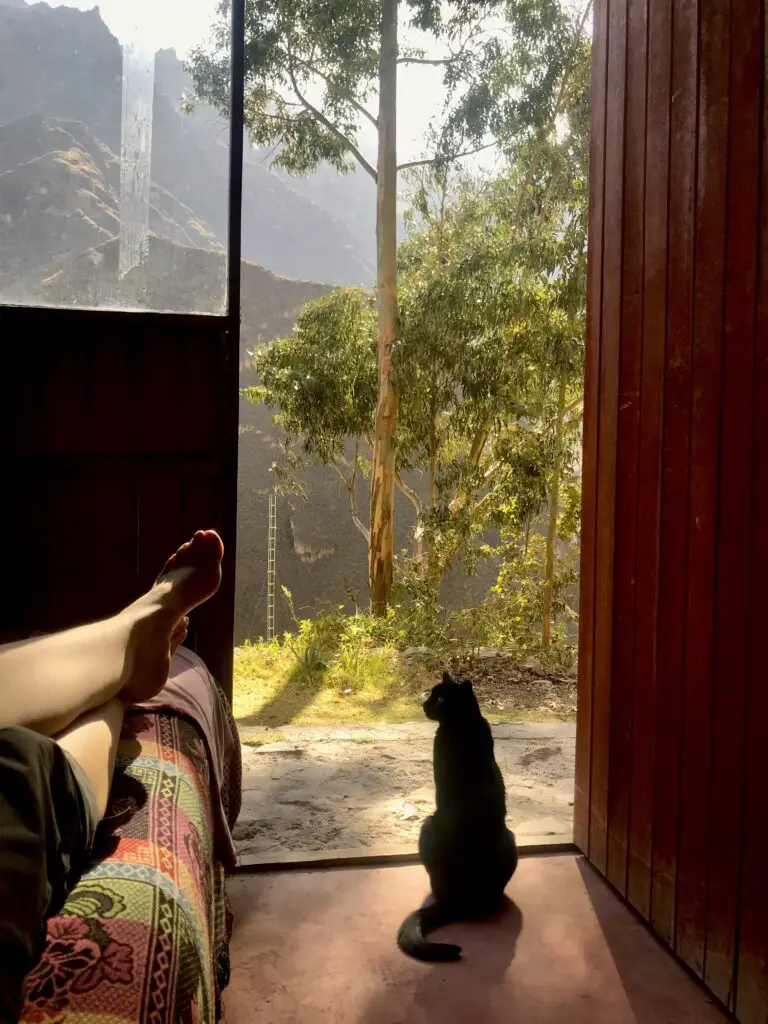
Day 3: the mountains are messing with me
Fure to Sangalle (via Malata)
18k/11.2mi, 600m/1969ft of ascent, 1300m/4265ft of descent, 6:30 hours
Never did I had the need to focus on the geography of a place as much as I had to in the Colca Canyon. All the hiking I’ve ever done either had very clear signs (like in the Italian Dolomites or the Polish Tatras), or just one path with no way of missing it (like in Mestia, Georgia, or most of the treks in Cajón del Maipo, Chile). Here there are little villages every now and then, so you come across smaller shortcuts leading to them. There are also trails for taking animals for grazing. And older paths that were abandoned and replaced by either bigger or less steep ones. All of this is to tell you that it’s easy to get lost. So understanding the valleys and the overall direction to your destination is essential. In many forks the right trail felt obvious, with a big stone or a collection of small ones blocking the alternative. On others there was no way of knowing. But navigating this maze made me feel like an explorer.
This day was very demanding both physically and mentally. Not only I had to focus 100% on the actual path, but the up and downhills were very steep, as in close to 90° at some points from Fure to Belén.
From Belén it gets easier. There is an actual dirt road for cars to Mirador Apachata, and a fairly hidden path above it, kind of in parallel (if you want to avoid walking on the dirt road). They go really gently up. And then from the viewpoint, you just follow the road. There’s a very steep path down to Sangalle, but during my trek it was closed due to landslides. So I had to add a few kilometers going up and then downhill to the town of Malata, and then find the way down to the valley where Sangalle is.
It was the longest hiking day, with 18k/11mi and many blisters in my feet. But my accommodation had a swimming pool, so the afternoon was spent resting and reading. And staring at the route for tomorrow that was mocking me while I was trying to relax, those endless zigzags up to the trees in the ridge back to Cabanaconde.
Extract from my journal
My legs burn, but my soul is full. I set myself for a challenge I didn’t know if I had the strength to accomplish, and I’m 3 days in, tired as hell, but happy. I remember feeling a bit like this after climbing Villarrica volcano. More than being fit, what’s needed is to have a strong mind. If you believe you can do it, then you absolutely can.
[…]
I don’t remember when or how my dad taught me about mountaineering. He was never too keen on me following his footsteps, and he had to quit it when I was very young anyways. I remember walks in the forest when we visited the Lake District during summer holidays, and day trips around a river close to our home. Anyhow, he did teach me. Because I never took any course or class on how to tackle a mountain, yet I know what I’m doing. I know how to correctly step going down, how to secure myself going up, what to look for to safely cross a river. Not only this knowledge has been incredibly handy, but every time I realize I’m handling myself correctly and safely, I feel like dad is walking with me, guiding my steps.
Accommodation: plenty of options in the oasis of Sangalle, the most touristy of the villages in this side of the canyon. Most will offer a bar and a swimming pool. I chose the cheapest one that wasn’t fully booked, Oasis Paraíso Ecolodge, and it turned out to be very nice.
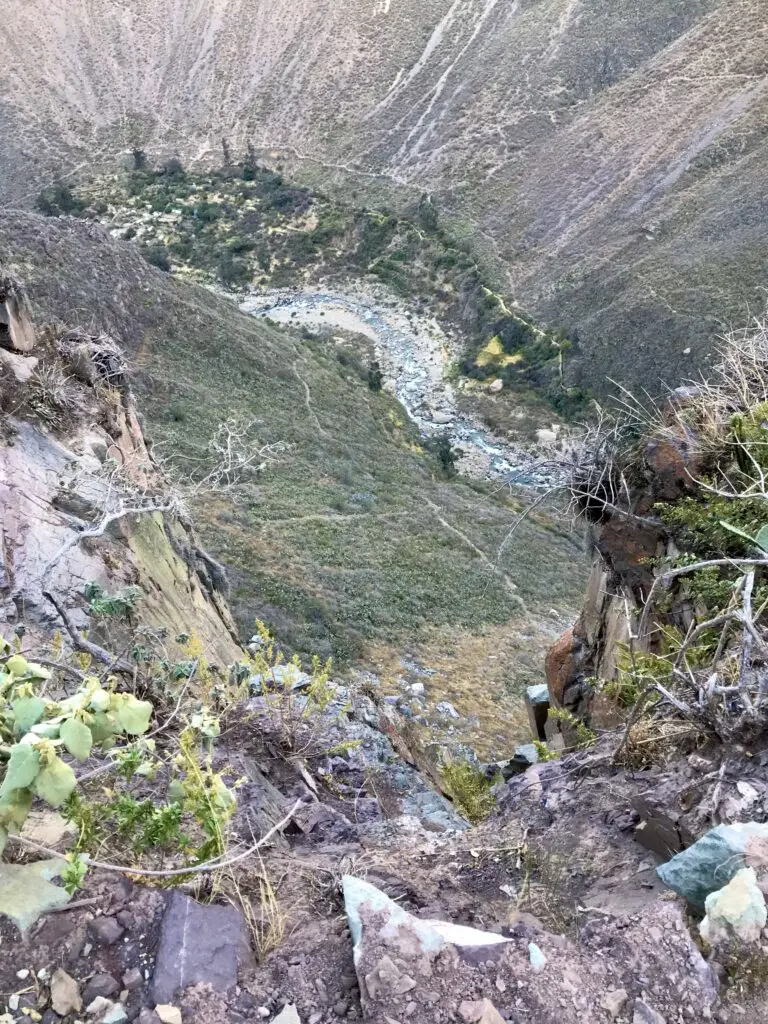

Day 4: it’s all uphill to the trees
Sangalle to Cabanaconde
4.5k/2.8mi, 1300m/4265ft of ascent, 50m/164ft of descent, 4:40 hours
Most people start the hike back up to Cabanaconde at around 4 AM, in the dark, to avoid the heat. I wasn’t going to submit myself to that torture, so I set my alarm at 6 thinking of starting at 7, with daylight. But I woke up earlier than expected. I don’t know if it was the anticipation for what I thought would be the hardest day, or the fact that the night before I fell asleep at around 8 PM. Whatever the reason, I was having breakfast at 5:30. Well, mostly having coffee and nibbling on a piece of bread with jam. By 6 I already had my backpack on, and I was leaving the accommodation. It took me a few minutes to figure out the path. Since there are no signs and no one was around to ask, I just picked the steepest one up. It proved to be the right choice.
As I went up and up and up, my mind went through stages. “Wow, this is not too hard, I can absolutely do it”. “Goddamit! Why do I keep doing this to myself!?!?”. “Nope, it’s impossible, I live in the mountain now”, “I’m doing wonderfully, only my back aches a bit, my legs are fine, I’m breathing through my nose —I got this”. “Alright, I’m not having fun here, but it’s not so bad”. “This pace is excruciatingly slow, I’ll spend my whole life in this canyon!”. “I’m reaching the treesssss, the treeeeeeesssss”.
Other than all the voices in my head taking over one or two at the time, the hike up was uneventful. I walked very slowly and steady, taking breaks to drink water or eat some nuts, stopping quickly to take photos, and moving to the side to let the few other non-early birds overtake me. After about 4 hours and 15 minutes I reached the trees, those that looked at me from above when I was staring at the route the day before. There’s a nice viewpoint by the trees (Mirador de Cejana). From there it was another 15-20 on a slight downhill to the center of Cabanaconde.
I went straight to book the ticket for the bus back to Arequipa, then to get the things I left at my first accommodation, and back to the main square to wait for the bus (and eat my last can of beans while waiting, because glamour, right?).
When I finally sat down I realized that I made it. Four days of trekking alone in one of the deepest canyons in the world. 42.5k/26.4mi, 2950m/9679ft of elevation gained and 2750m/9022ft of downhill. I set myself for a challenge and I passed it with flying colors. It ended up being a full marathon around the Colca Canyon!
I hope that in the future I’ll look back at this post and laugh about how hard it was because now these distances and elevations are easy-peasy for me. But now I’m very proud, that’s why I decided to write about the experience, in hopes of inspiring you to take up the challenge too : )
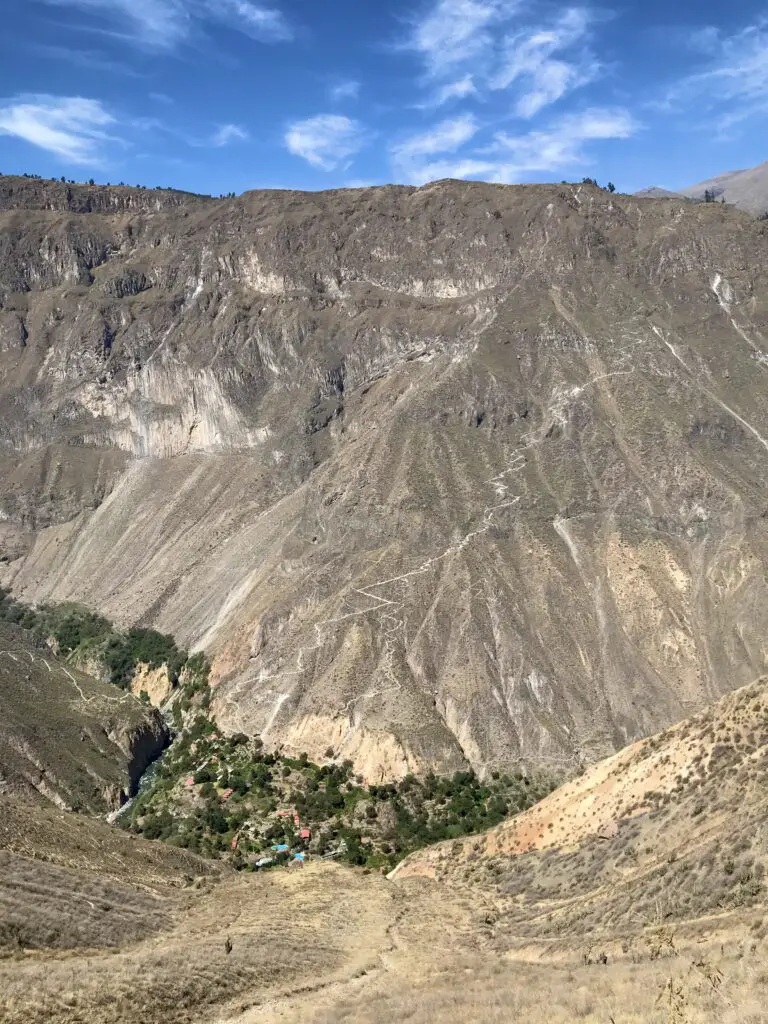
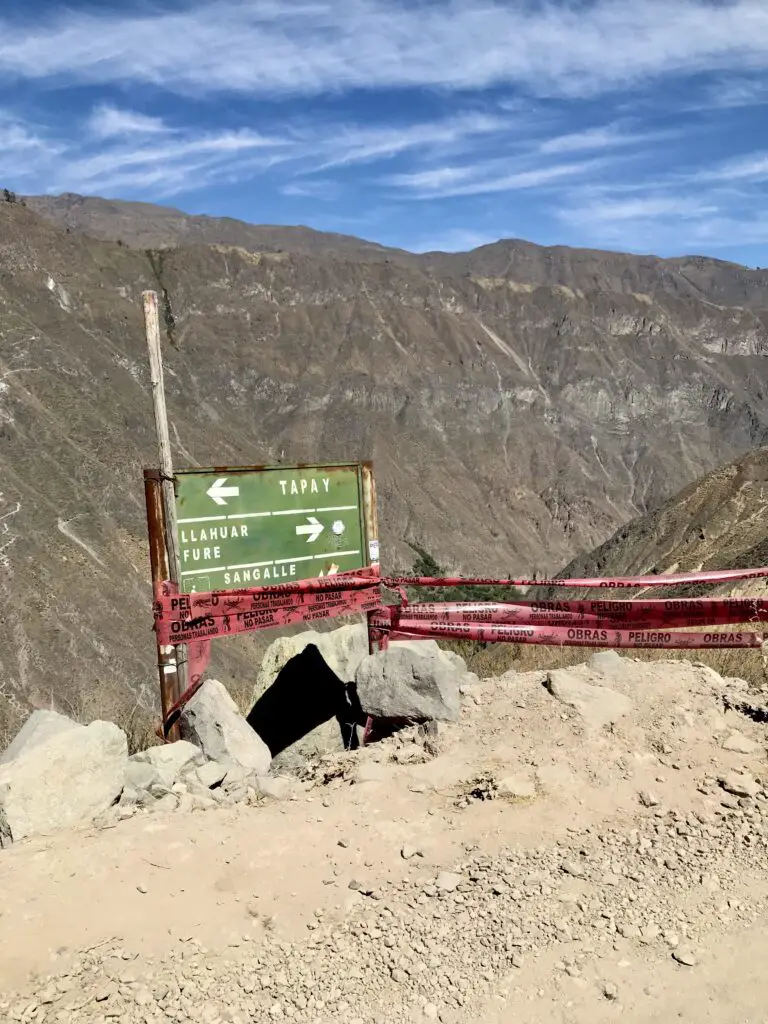
All you need to know before trekking the Colca Canyon on your own
Where is the Colca Canyon and how do I reach it independently?
The town of Chivay is the entry point and the main town of the Colca Canyon. It’s located about 160k/100mi northwest of Arequipa.
Reaching Chivay is easy. There are buses a few times a day from Arequipa’s main bus station, and colectivos (shared minivans) leaving the city as soon as they get filled, throughout the whole day, from Avenida Andres Avelino Cáceres (look for Transportes Centella or Transporte Camino del Inca in Google Maps). The ride takes about three and a half hours.
There are also buses going straight to Cabanaconde, further into the canyon, at about 220k/135 mi from Arequipa. Or you can take a colectivo from Chivay to get the last leg done. Allow about 5-6 hours for the whole trip, as the road conditions make it slow.
If you want to start hiking on the same day as you leave Arequipa you’ll need to begin ridiculously early, at around 3-4 AM. There’re companies that, for about 20 USD, will pick you up in Arequipa at 3 AM, stop on the way to have breakfast, and then for a bit of sightseeing at the Mirador de Cóndores (where you can see the majestic Andean vultures), and drop you of at Cabanaconde. Another option is to take the first bus, at 4:30 AM, for only about 5 USD.
A much nicer option, if you have the time, is to go the day before, enjoy the stunning landscape from your window at a less ungodly hour, and spend a night in Cabanaconde so you start the trek rested.
Do I need a guide or a tour from an agency?
The simplest answer is that you don’t, but you might want to, depending on your confidence levels and on the time you have. I did it completely independently, allowing 5 days for a 4-day hike, and I felt safe and at ease.
If you would prefer to have a guide, the are 2 or 3-day options (like this one or this one) many agencies at Arequipa’s main square offer plenty of options. I wouldn’t recommend a day trip, since you’d spend most of your time on a bus, with almost no hiking. But the multiday alternatives will allow you to trek without worrying about transport, accommodation, food, or finding the correct path.
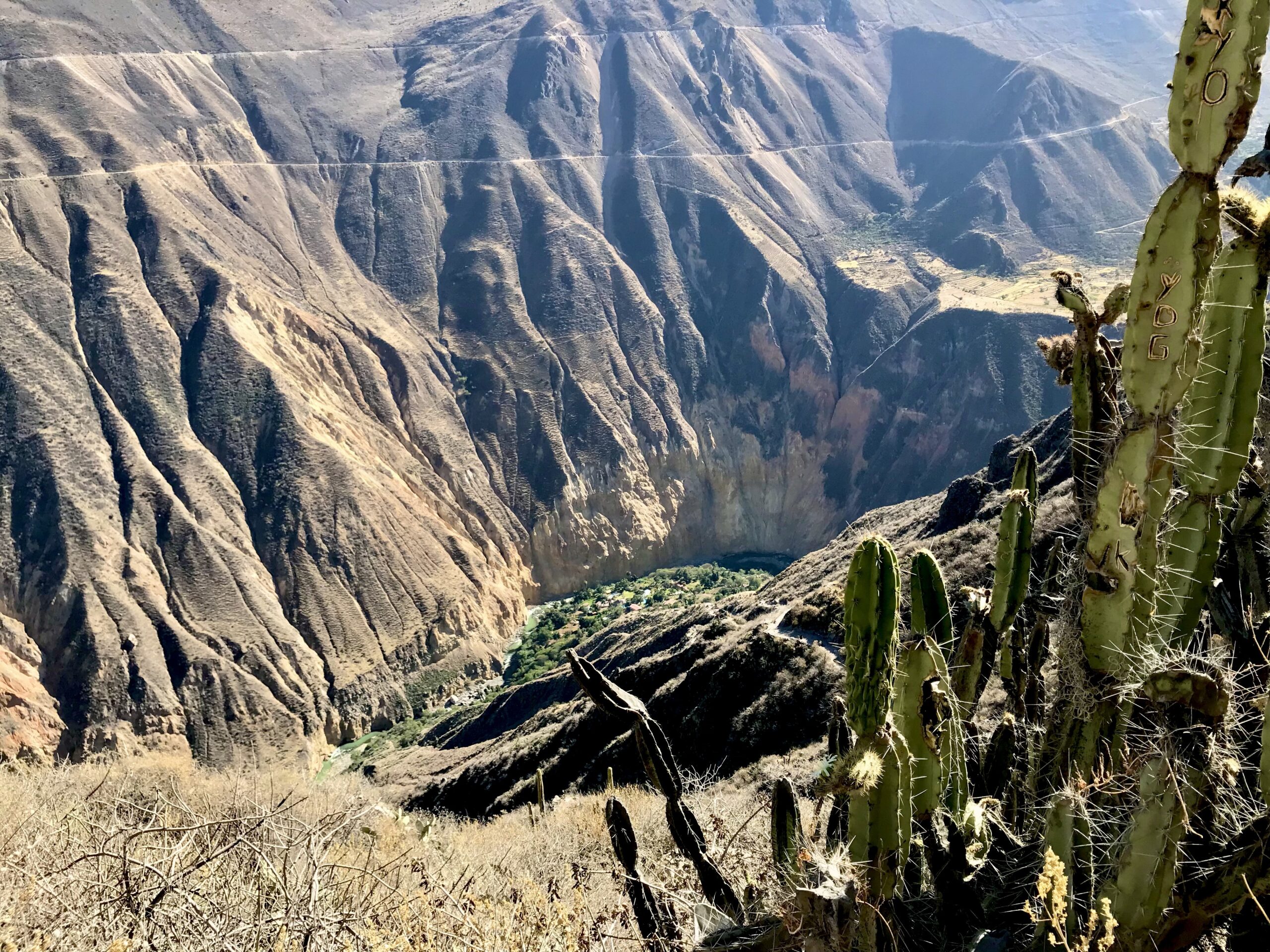
How long should I go and what route should I take?
There are as many options as you can count. The canyon is huge, and the paths are endless. For all I read and heard, the best-looking ones are from Cabanaconde (instead of Chivay), so that’s where I decided to start.
The next question is how long you have. Some people go down to Sangalle, spend the night there and go back up. With 3 days you can go to Llahuar and then Sangalle. With 4 you can add a stop in Fure in between. I had time, so I decided on four days.
What about food and accommodation?
Accommodation: depends on where you’re going, you’ll find only one option (like in Fure), or several alternatives (like in Sangalle). They all have WiFi, and meal options. You can book ahead through booking.com for most stops.
Food: all accommodations will include breakfast, and for an additional fee, they offer a simple dinner and a take-away lunch box, plus bottled water and snacks. In my experience dinner was a soup and a main dish, a vegetarian option and a “normal” one. It usually was vegetable soup followed by pasta with chicken, or an omelet with rice. For what I saw lunch boxes contain a sandwich and a banana. If you’re vegan, bring your food.
As I wasn’t sure about what I’d find, I went prepared. I stopped at a supermarket in Arequipa and got cans of beans (the Mexican kind you put in burritos, that are prepared with onions and tomatoes, so are kind of nice to eat directly from the can), a few packs of cookies, and nuts.
What should I bring?
The basics are a water filter (this is the one I took), rehydration packs, sunscreen, a first aid kit, a bathing suit (for the hot springs in Llahuar and the swimming pool in Sangalle), a torch, and warm layers for the cold nights. Snacks like energy bars, nuts or sweets are very useful too, although you can get those in the canyon (with a huge mark up, of course). If you’re vegan, bring all the food you’ll have, since there are almost no options in the canyon.
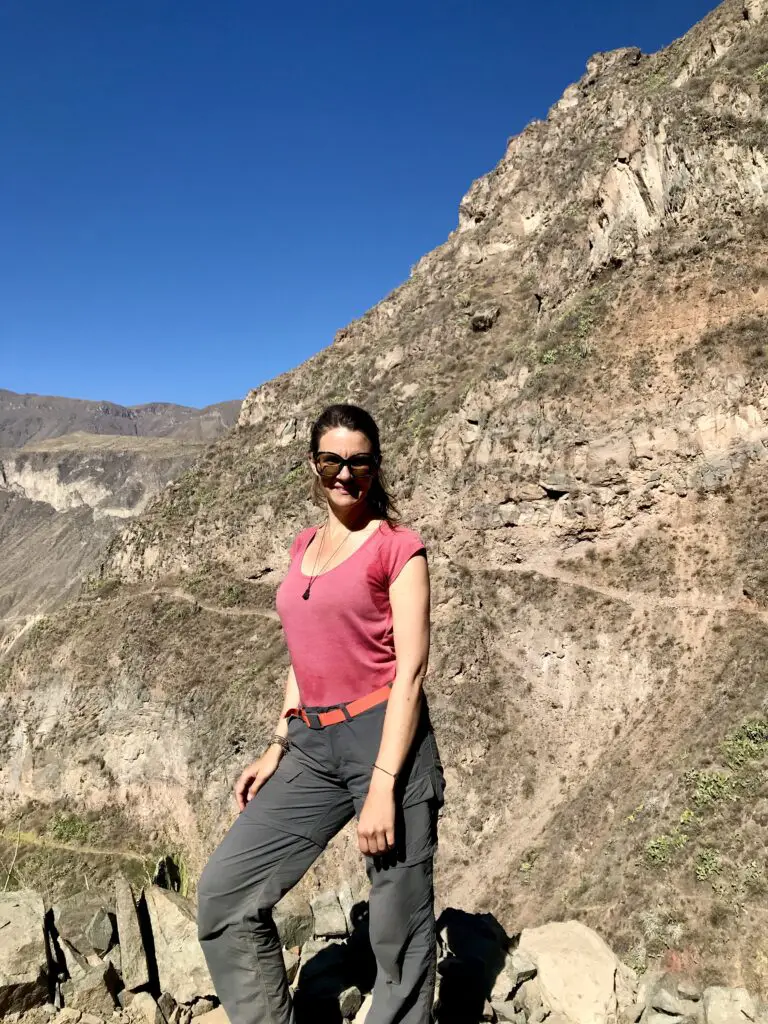
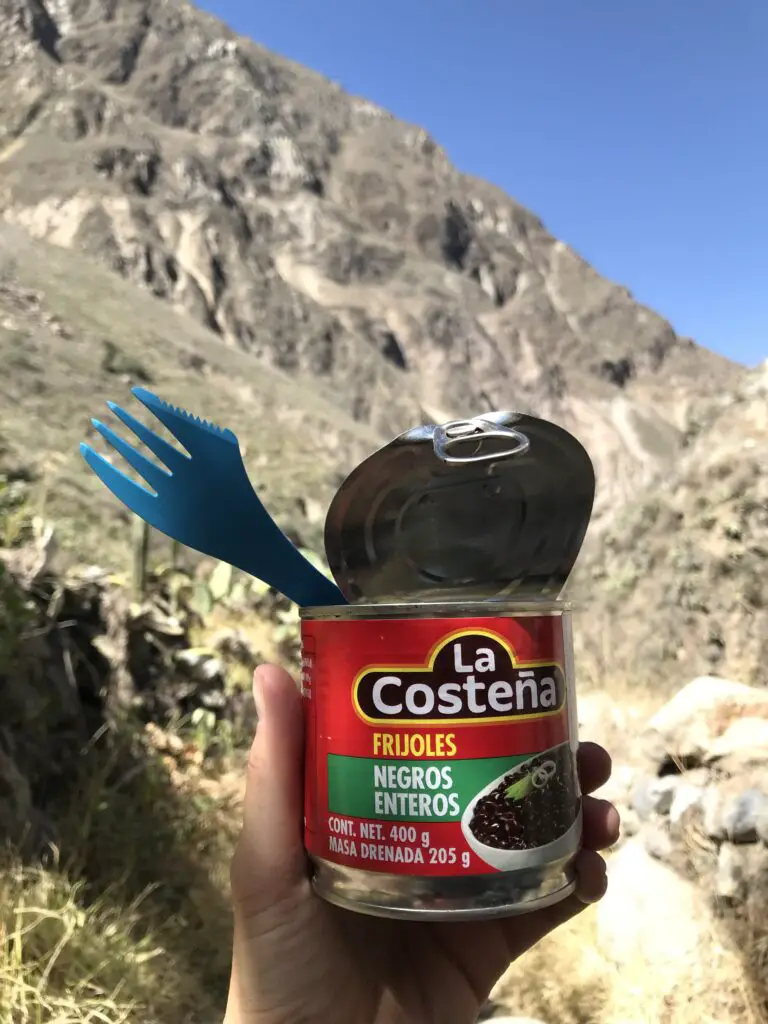
What if something happens?
I obviously can’t guarantee that nothing will happen, but I can assure you that I felt very safe.
Occasionally there is mobile signal, so you should be able to communicate with the outside-of-the-canyon world. Some legs are very popular, so you should also see other hikers, and in the ones that are not too touristy, you’ll probably run into locals. In any case, let the host of the accommodation you’re starting from know where you’re heading, so in case you don’t reach out that evening confirming your safe arrival, they know they should send help. All the lodgings have electricity and WiFi, so this is easy to arrange.
It’s also worth noting that there are some places inside the canyon from where you can get a taxi back up, and locals with mules or horses can take you there from any village.
Any tips on how to handle the paths?
The best advice I can give you is that when going steep up or down, especially if you have a deep canyon with hundreds of meters to your side, focus only on the way, one hundred percent, there’s nothing else in the world. The views are gorgeous, but you’ll have better moments to appreciate them.
It’s also important to take short steps and try to find secure points, like a rock that’s anchored and sticking up a bit. Go slow and steady. Hands always free. Your phone, camera, water bottle, literally everything goes in your backpack. Don’t be afraid to use your hands, whether it is that you have rocks or trunks on the side, or if you can hold on to rocks or roots on the floor. You can also sit so your bump creates another anchor point that allows you to use your heels as a brake as you slowly slide down. Having more of yourself connected to the path is always safer.
Now, if you’re afraid of heights or have vertigo, DO NOT attempt a trek in the canyon. The paths are narrow, sometimes very very narrow, and the drop down the cliff is massive. It’s safe, but you can easily lose control if you’re scared.
How much should I budget for the trek?
This is tricky to reply because it depends on whether you’ll get a guide or not, how long you plan to hike for, and which accommodation you’ll choose (in the places where you have a choice, that is). But I can walk you through all of my expenses : )
S/.50 supermarket in Arequipa (cans of beans, cookies, nuts)
S/.40 colectivo (shared minivan) Arequipa – Chivay – Cabanaconde (it’s cheaper if you find a bus directly to Cabanaconde, but they are less frequent)
S/.70 accommodation in Cabanaconde 1 night
S/.40 dinner and map purchased in Cabanaconde
S/.40 entrance to Colca Canyon (it’s S/.70 for non-South American passport holders)
S/.50 accommodation in Llahuar 1 night
S/.20 dinner in Llahuar
S/.40 accommodation in Fure 1 night
S/.20 dinner in Fure
S/.76 accommodation in Sangalle 1 night
S/.25 dinner in Sangalle
S/.54 bananas and water bottles in the canyon
S/.25 bus Cabanaconde to Arequipa
TOTAL S/.110 a day, for 5 days = ~28 USD a day
Would you recommend solo trekking the Colca Canyon?
Short and sweet: absolutely!

There’s so much raw beauty in the Colca Canyon. Even though it has become a very touristy destination within Perú, if you go a bit deeper than the crowds, the rewards are spectacular. Trekking around such a magnificent place makes you see how small we humans are, but how much strength we can have.
I went through what I thought were the main questions about the place and the trek, and I shared all the details I could about my own experience, but if you have any other doubts about how to solo trek the Colca Canyon, don’t hesitate to ask me in the comments : )
WHAT TO READ NEXT?
- Eco-friendly hiking: sustainable tips and packing guide
- Travel resources: the best travel tips and tricks
- The ULTIMATE Travel Experiences Bucket List
- The Chilean Lake District: hiking, climbing an active volcano and more
- Travel lessons: what visiting 50+ countries has taught me
Liked it? Want to read it later? Pin it!

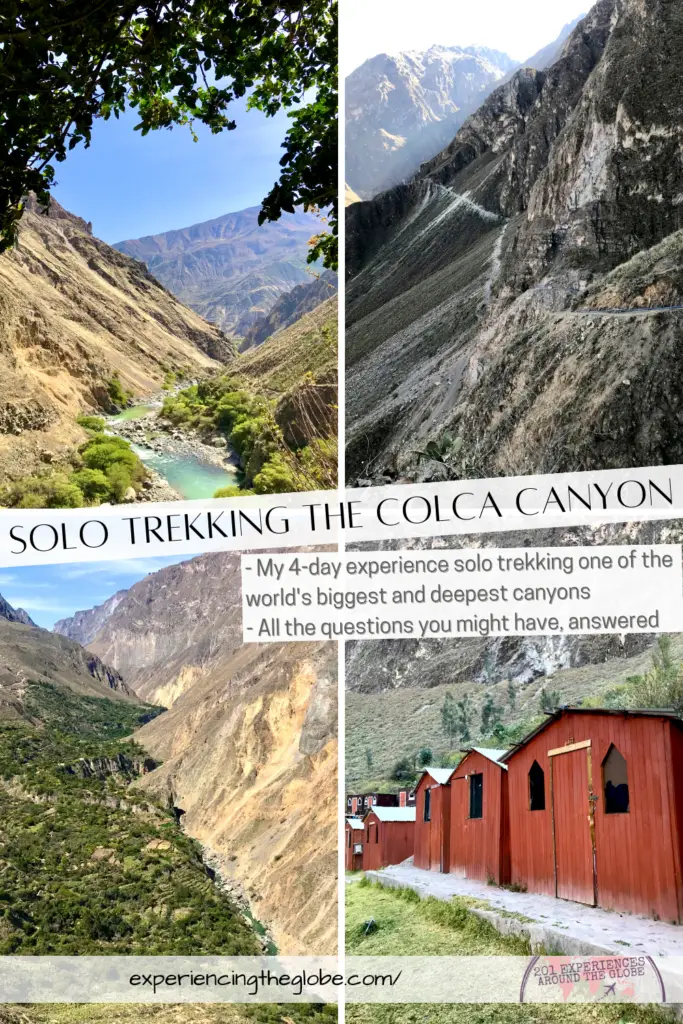
Did you like what you read? You can show your appreciation by buying me a coffee 🙂
Your support will ensure I keep bringing you stories and insights from around the world! Thanks so much!



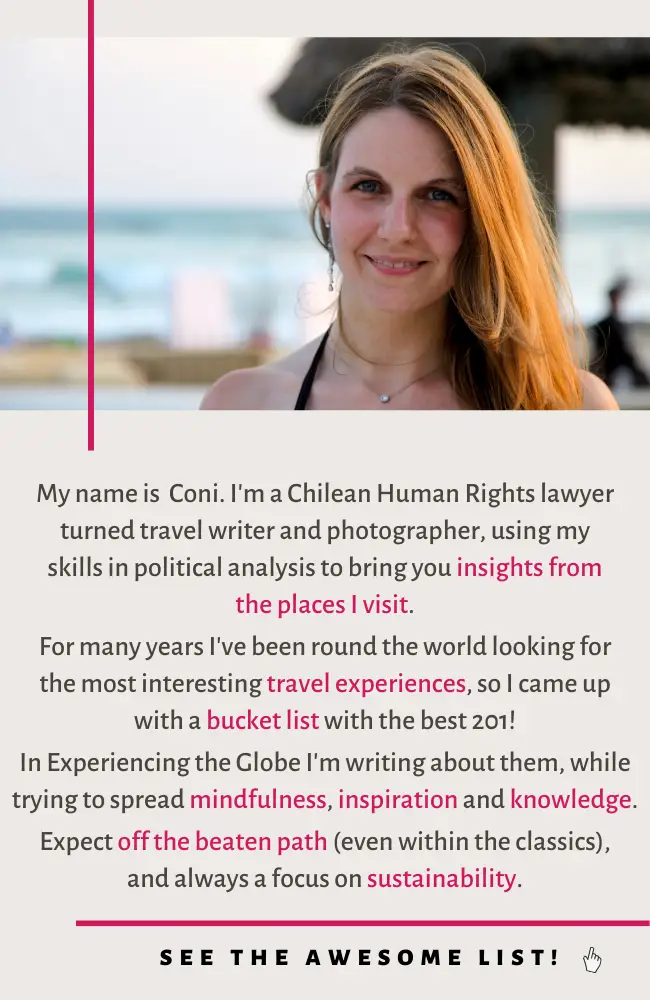
Wow, what an amazing adventure! You did a great job of describing the solo trekking the Colca Canyon experience and what to expect. I loved the photos and the stories of the places you visited. I’m amazed by the beauty and diversity of the canyon, and by your stamina and determination to complete the hike. You also provided some valuable information and tips for planning a trip to the canyon.
This type of hiking experience is what I crave for. The view from the hammock at Casa de Virginia, Llahuar is breath-taking. The lodging option in Fure is unique. Did you really have a local friend in the cabin or its photoshopped?